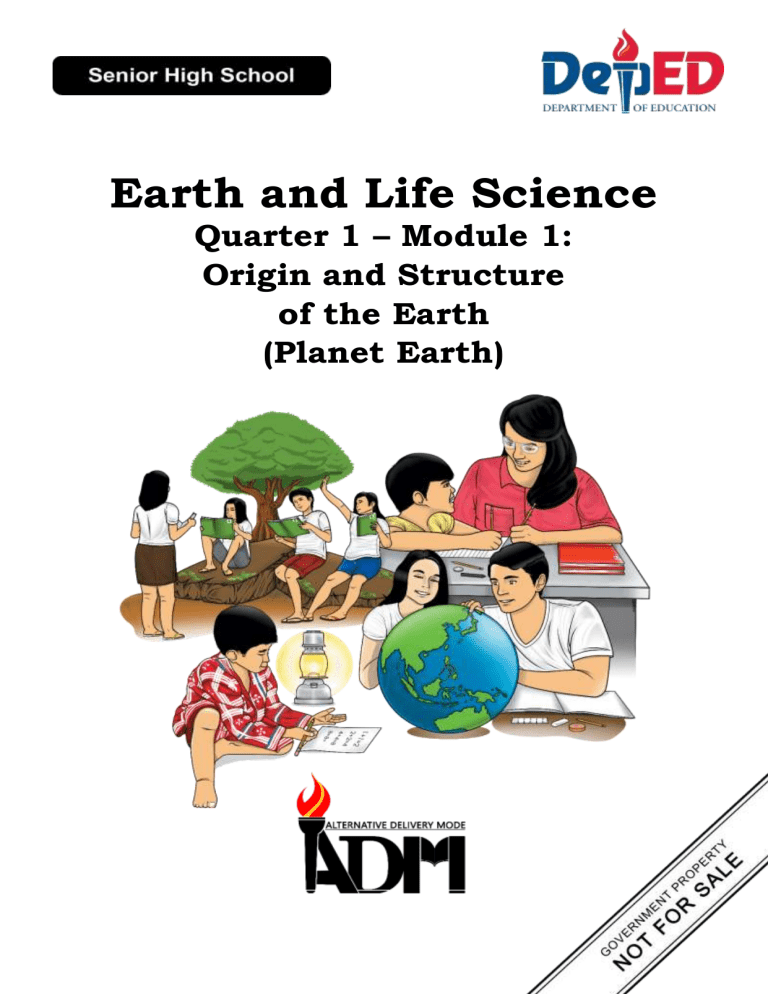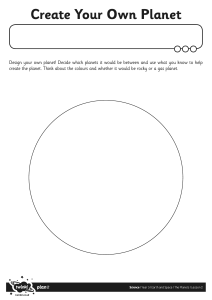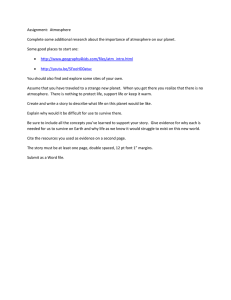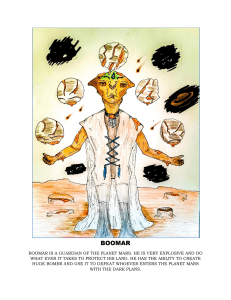
Earth and Life Science Quarter 1 – Module 1: Origin and Structure of the Earth (Planet Earth) Earth and Life Science Alternative Delivery Mode Quarter 1 – Module 1: Origin and Structure of the Earth – Planet Earth First Edition, 2020 Republic Act 8293, Section 176 states that: No copyright shall subsist in any work of the Government of the Philippines. However, prior approval of the government agency or office wherein the work is created shall be necessary for exploitation of such work for profit. Such agency or office may, among other things, impose as a condition the payment of royalties. Borrowed materials (i.e., songs, stories, poems, pictures, photos, brand names, trademarks, etc.) included in this module are owned by their respective copyright holders. Every effort has been exerted to locate and seek permission to use these materials from their respective copyright owners. The publisher and authors do not represent nor claim ownership over them. Published by the Department of Education Secretary: Leonor Magtolis Briones Undersecretary: Diosdado M. San Antonio Development Team of the Module Writers: Rochelle M. Mercado Editors: Melanie I. Samudio Jocelyn M. Manset Reviewer: Jason Ricaforte, Angelica Beriña, Princess Paolah L. De Guzman, Marissa C. Betchaida Louie L. Alvarez, Gregorio M. De Chavez, Jr., Jocelyn M. Manset, Mario B. Maramot, Elaine T. Balaogan, Job S. Zape Jr. Illustrator: Ednelinda Robles, Lovely Joy La Rosa, Charles Erick A. Jusay, Sandro Carlo B. Tablizo Layout Artist: Elizalde L. Piol, Anselma M. Ebero Jocelyn M. Manset Management Team: Wilfredo E. Cabral Job S. Zape Jr. Eugenio S. Adrao Elaine T. Balaogan Merthel M. Evardome Nadine C. Celindro Nicolas M. Burgos Mario B. Maramot Fe M. Ong-ongowan Rosalinda A. Mendoza Printed in the Philippines by ________________________ Department of Education – Region IV-A CALABARZON Office Address: Telefax: E-mail Address: Gate 2 Karangalan Village, Barangay San Isidro Cainta, Rizal 1800 02-8682-5773/8684-4914/8647-7487 region4a@deped.gov.ph Earth anf Life Science Quarter 1 – Module 1: Origin and Structure Of the Earth (Planet Earth) Introductory Message For the facilitator: Welcome to the Earth and Life Science Grade 11 Alternative Delivery Mode (ADM) Module on Origin and Structure of the Earth – Planet Earth! This module was collaboratively designed, developed, and reviewed by educators both from public and private institutions to assist you, the teacher or facilitator, in helping the learners meet the standards set by the K to 12 Curriculum while overcoming their personal, social, and economic constraints in schooling. This learning resource hopes to engage the learners into guided and independent learning activities at their own pace and time. Furthermore, this also aims to help learners acquire the needed 21st century skills while taking into consideration their needs and circumstances. In addition to the material in the main text, you will also see this box in the body of the module: Notes to the Teacher This contains helpful tips or strategies that will help you in guiding the learners. As a facilitator, you are expected to orient the learners on how to use this module. You also need to keep track of the learners' progress while allowing them to manage their own learning. Furthermore, you are expected to encourage and assist the learners as they do the tasks included in the module. ii For the learner: Welcome to the Earth and Life Science Alternative Delivery Mode (ADM) Module on Origin and Structure of the Earth – Planet Earth! The hand is one of the most symbolized parts of the human body. It is often used to depict skill, action, and purpose. Through our hands, we may learn, create, and accomplish many things. Hence, the hand in this learning resource signifies that you, as a learner, are capable and empowered to successfully achieve the relevant competencies and skills at your own pace and time. Your academic success lies in your own hands! This module was designed to provide you with fun and meaningful opportunities for guided and independent learning at your own pace and time. You will be enabled to process the contents of the learning resource while being an active learner. This module has the following parts and corresponding icons: What I Need to Know This will give you an idea of the skills or competencies you are expected to learn in the module. What I Know This part includes an activity that aims to check what you already know about the lesson to take. If you get all the answers correct (100%), you may decide to skip this module. What’s In This is a brief drill or review to help you link the current lesson with the previous one. What’s New In this portion, the new lesson will be introduced to you in various ways such as a story, a song, a poem, a problem opener, an activity or a situation. What is It This section provides a brief discussion of the lesson. This aims to help you discover and understand new concepts and skills. What’s More This comprises activities for independent practice to solidify your understanding and skills of the topic. You may check the answers to the exercises using the Answer Key at the end of the module. What I Have Learned This includes questions or blank sentence/paragraph to be filled in to process what you learned from the lesson. iii What I Can Do This section provides an activity which will help you transfer your new knowledge or skill into real life situations or concerns. Assessment This is a task which aims to evaluate your level of mastery in achieving the learning competency. Additional Activities In this portion, another activity will be given to you to enrich your knowledge or skill of the lesson learned. This also tends retention of learned concepts. Answer Key This contains answers to all activities in the module. At the end of this module you will also find: References This is a list of all sources used in developing this module. The following are some reminders in using this module: 1. Use the module with care. Do not put unnecessary mark/s on any part of the module. Use a separate sheet of paper in answering the exercises. 2. Don’t forget to answer What I Know before moving on to the other activities included in the module. 3. Read the instructions carefully before doing each task. 4. Observe honesty and integrity in doing the tasks and checking your answers. 5. Finish the task at hand before proceeding to the next. 6. Return this module to your teacher/facilitator once you are through with it. If you encounter any difficulty in answering the tasks in this module, do not hesitate to consult your teacher or facilitator. Always bear in mind that you are not alone. We hope that through this material, you will experience meaningful learning and gain deep understanding of the relevant competencies. You can do it! iv What I Need to Know This module was designed and written with you in mind. It is here to help you master the nature of Earth and Life Science. The scope of this module permits it to be used in many different learning situations. The language used recognizes the diverse vocabulary level of students. The lessons are arranged to follow the standard sequence of the course. But the order in which you read them can be changed to correspond with the textbook you are now using. The module focuses on the lesson: Lesson 1 – Planet Earth After going through this module, you are expected to: 1. identify the characteristics of the Earth that supports life; and 2. expound how the characteristics of the Earth sustain the needs of living organism. What I Know Choose the letter of the best answer. Write the chosen letter on a separate sheet of paper. 1. Why is Earth called “the living planet?” A. It sustains life. C. It has water at the surface B. It has atmosphere D. All of the above 2. Which among the set of planets are called terrestrial? A. Jupiter, Neptune, Uranus B. Mercury, Venus, Mars, Earth C. Earth, Venus, Mars, Jupiter D. Jupiter, Saturn, Uranus, Neptune 3. What makes planet Earth uniquely different from other planets? A. It has soil. C. It has people. B. It has tress. D. It has liquid water. 4. What makes planet Earth habitable? A. It has comfortable distance from the sun. B. It has atmosphere that protects from radiation. C. The atmosphere holds carbon dioxide and other gases. D. All of the above 5. Why is Earth called a terrestrial planet? A. It has life C. It is farther from the sun B. It is closest to the sun D. It is placed at almost the middle planets 1 6. Which of the following best describes the surface of the planet Earth? A. a thick layer of hydrogen gas B. cloudy and hot with lots of volcano C. cold, rocky, and covered with red dust D. mostly water surface with some areas of land 7. What makes Earth different from other planets in the solar system? A. It supports life. B. It is mostly covered in water. C. Its atmosphere is mostly nitrogen and oxygen. D. All of the above 8. Earth is the only planet that can support ___ A. life C. a rocky core B. a moon D. an atmosphere 9. How many percent of water comprises the Earth? A. 15% C. 50% B. 30% D. 70% 10. What are the factors that make Earth habitable? A. temperature and nutrient C. only A B. atmosphere and energy D. both A and B 11. What nutrients does the Earth have to maintain an organism’s body to survive? A. Earth has a water cycle and atmosphere B. Earth has volcanic activities to circulate nutrients. C. Earth has sub-surface water or molten rock that can circulate and replenish nutrients for organisms. D. All of the above 12. What makes Earth similar to Venus? A. Earth and Venus are the right sizes to hold a sufficient atmosphere. B. Venus’ atmosphere is 100 times thicker than Earth. C. Among all the solid planets and moons, only Earth, Venus, and Titan have significant atmospheres. D. Both A and C 13. Why are humans and other living organisms capable to live on earth? A. Earth has no protective equipment like ozone. B. Earth has layer water only for favorable climate. C. Earth has man-made natural cycles D. Earth’s temperature is neither the hottest nor the coldest among other planets. 14. What makes Earth different from any other planets in the Solar System? A. It is the only rocky planet. B. It is the only planet that turns around in space. C. It is the only planet that has a large amount of liquid water. D. It is the only planet that changes its structure 15. What does Earth offer to human for survival? A. Earth has abundant plant life. B. Earth has sufficient nutrients from ocean to land. C. Only A D. Both A and B. 2 Lesson 1 Origin and Structure of the Earth- Planet Earth Earth is the only planet in the solar system known to harbour life. Our planet’s has molten nickel-iron core give rise to an extensive magnetic field, which, along with the atmosphere, shields us from harmful radiation coming from the Sun. In this module, you will understand why this planet is called the “living planet.” What’s In Just a part of the vast universe is the solar system. From the previous concepts learned, identify the planets in the solar system in the given illustration. Question: What do you think are the characteristics of the planet Earth that make it different from all the other planets? Notes to the Teacher This module focuses on identifying the similarities and differences among Earth and neighbouring planets and the factors that make a planet habitable. 3 What’s New Earth: A Habitable Planet Read the document carefully and answer the questions that follow Table 1. Factors that make a planet habitable Factors that make a Planet Habitable Not Enough of the Factor Just Right Too Much of the Factor Situation in the Solar System Temperature influences how quickly atoms and molecules move. Low temperatures cause chemicals to react slowly, which interferes with the reactions necessary for life. It can also cause the freezing of water, making liquid water unavailable. Life seems to be limited to a temperature range of -15oC to 115oC. In this range, liquid water can still exist under certain conditions. At about 125oC, protein and carbohydrate molecules, and the genetic material (e.g., DNA and RNA) start to break apart. Also, high temperatures cause the quick evaporation of water. Surface: only the Earth’s surface is in this temperature range. Sub-surface: the interior of the solid planets and moons may be in this temperature range. Atmosphere Small planets and moons have insufficient gravity to hold an atmosphere. The gas molecules escape to space, leaving the planet or moon without an insulating blanket or a protective shield. Earth and Venus are the right size to hold a sufficient atmosphere. Earth’s atmosphere is about 100 miles thick. It keeps the surface warm and protects it from radiation and small- to mediumsized meteorites. Venus’s atmosphere is 100 times thicker than Earth’s. It is made almost entirely of greenhouse gasses, making the surface too hot for life. The four giant planets are completely made of gas. Of the solid planets and moons, only Earth, Venus, and Titan have significant atmospheres. Mars’ atmosphere is about 1/100th that of Earth’s, too small for significant insulation or shielding. Energy When there is too little sunlight or too few of the chemicals that provide energy to cells, such as iron or sulfur, organisms die. With a steady input of either light or chemical energy, cells can run the chemical reactions necessary for life. Light energy is a problem if it makes a planet too hot or if there are too many harmful rays, such as ultraviolet. Too many energy-rich chemicals is not a problem Surface: The inner planets get too much sunlight for life. The outer planets get too little. Without chemicals to make proteins and carbohydrates, organisms cannot grow. Planets without systems to deliver nutrients to its organisms (e.g., a water cycle or volcanic activity) cannot support life. Also, when nutrients are spread so thin that they are hard to obtain, such as on a gas planet, life cannot exist. All solid planets and moons have the same general chemical makeup, so nutrients are present. Those with a water cycle or volcanic activity can transport and replenish the chemicals required by living organisms. Too many nutrients are not a problem. However, too active a circulation system, such as the constant volcanism on Jupiter’s moon, Io, or the churning atmospheres of the gas planets, interferes with an organism’s ability to get enough nutrients. Surface: Earth has a water cycle, an atmosphere, and volcanoes to circulate nutrients. Venus, Titan, Io, and Mars have nutrients and ways to circulate them to organisms. Nutrients used to build and maintain an organism’s body. Sub-surface: Most solid planets and moons have energy-rich chemicals. Sub-surface: Any planet or moon with sub-surface water or molten rock can circulate and replenish nutrients for organisms Factors that make a planet habitable. National Science Foundation, n,d.http://www.lpi.usara.edu/education/explore/our_place/hab_ref_table.pdf Question: 1. What are the factors that make the planet habitable? 2. What are the characteristics of planet Earth that makes it habitable? 4 What is It Earth is the only place in the known universe confirmed to host life and is the only one known for sure to have liquid water in the surface. These are reasons why planet earth is a unique one: (1) It has liquid water; (2) Plate Tectonics; and (3) It has atmosphere that shelters it from the worst of the sun’s rays. Earth is the only planet in the solar system that has a large amount of liquid water. About 70% of the surface of the Earth is covered by liquid or frozen water. Because of this, Earth is sometimes called “blue planet.” Planet Earth is habitable because it has the right distance from the sun. It is kept warm by an insulating atmosphere, and it has the right chemical ingredients for life including water and carbon. It can provide water, oxygen, useful biological products for human, and has suitable weather and climate. Earth, Venus, and Mars may have similarities: (1) They all are terrestrial planets, made of solid rocks and silicates; (2) They all have an atmosphere; (3) They all almost have the same time to rotate on their axes; (4) Earth and Mars both have water; (5) They all have carbon dioxide; and (6 All have landforms. Earth, Venus, and Mars have differences: (1) Venus has no water; (2) Venus and Mars don’t have oxygen; and (3) Earth has life forms. What’s More Activity 1.1 Understanding Planet Earth Compare and Contrast How is planet Earth similar and different from Venus and Mars? Provide possible explanations for your observations using the information in the table. VENUS EARTH Mass (1024kg) 4.87 5.97 Diameter (km) 12,104 12,756 Density (kg/m3) 5243 5514 Gravity (m/s2) 8.9 9.8 Escape Velocity (km/s) 10.4 11.2 Surface pressure (bars) 92 1 Composition of atmosphere 96% CO2, 3.5% N 77%N, 21% O2, 1%Ar Major Greenhouse Gases(GHG) CO2 CO2 H2O Mean Temperature (0C) 464 15 Temperature if no greenhouse gases are -46 -18 present Changes in Temperature (0C) due to +523 +33 greenhouse gases Distance from the Sun (106km) 108.2 149.6 Orbital Period (days) 224.7 365.2 Orbital Velocity (km/s) 35 29.8 Length of day (hours) 2802 24 Global Magnetic Field No Yes Comparison of the features of Venus, Earth, and Mars (National Aeronautics and Space Administration, 2015) 5 MARS 0.642 6792 3933 3.7 5 0.01 95%CO2, 2.7%N, 1.6%Ar CO2 -65 -57 +10 227.9 687 24.1 24.7 No What I Have Learned 1. Planet Earth is considered habitable because of the following reasons: (1) it has the right distance from the sun; (2) it is protected from harmful solar radiation by its magnetic field; (3) it is kept warm by an insulating atmosphere; and (4) it has the right amount of ingredients for life, including water and carbon. 2. Earth is different from other planet in a way that it is the only planet with liquid water on the surface. a. Earth, Venus, and Mars may have similarities: (1) They all are terrestrial planets, made of solid rocks and silicates; (2) They all have an atmosphere; (3) They all almost have the same time to rotate on their axes; (4) Earth and Mars both have water; (5) They all have carbon dioxide; and (6) All have landforms. a. Earth, Venus, and Mars have differences: (1) Venus has no water; (2) Venus and Mars don’t have oxygen; and (3) Earth has life forms. What I Can Do Earth Day generally falls in the third week of April. There are a lot of great lessons about how our behavior and activity affect others and our planet. List down ten (10) activities that you can do to save planet Earth and identify those activities as a form of recycling, reducing, or reusing. RECYCLE REDUCE 6 REUSE Assessment Multiple Choice. Choose the letter of the best answer. Write the chosen letter on a separate sheet of paper. 1. What makes planet earth different from the other planets in the solar system? A. It supports life. C. The atmosphere holds gases. B. It is mostly covered in water. D. All of the above 2. Planet Earth is uniquely different from other planets because __________. A. It has people that live in it. B. It has soil where trees grow. C. It has trees that provide oxygen. D. It has liquid water in the surface. 3. What makes planet Earth habitable? A. It has comfortable distance from the sun. B. The atmosphere serves as shields from the sun. C. Only A D. Both A and B 4. Why is Earth called the “living planet?” A. It has life mechanism. B. It has water and atmosphere. C. It has carbon dioxide in the atmosphere. D. It has atmosphere that supports oxygen. 5. Which must be provided for an organism to survive in planet Earth? A. right amount of sunlight and atmosphere B. right amount of water and carbon C. Only A D. Both A and B 6. Planet Earth is considered as “blue planet.” Which of the following best describes the surface of planet Earth? A. Earth has atmosphere. B. Earth has lots of volcano. C. Earth is covered with red dust. D. Earth has mostly water on the surface. 7. What is the reason why Earth is different from other planets in the solar system? A. Earth is mostly covered in water. B. Earth has comfortable distance from the sun. C. Earth has carbon dioxide on its atmosphere. D. It has approximately same size as that of Venus. 8. Which of the following best describes planet Earth? A. It has gases. C. It has rocky core. B. It supports life. D. It supports other planet. 9. It was found out that Earth’s surface is covered with water. Approximately, how many percent of water comprises the Earth? A. 45% water C. 60% water B. 50% water D. 70% water 7 10. Earth can support the survival of organisms. What is/are the factor/s that make/s Earth habitable? I. atmosphere III. temperature II. energy IV. nutrient A. I C. I, II, III B. I, II D. I, II, III, IV 11. In order for an organism to survive, nutrients are needed. What are the nutrients that planet Earth can offer for an organism to exist? A. Earth has an atmosphere and ozone layer. B. Earth has both water cycle and nitrogen cycle. C. Earth has natural activities to circulate nutrients. D. All of the above 12. Many studies have shown similarities of Earth and Venus. What makes Earth similar with Venus? A. Earth and Venus have the same orbit. B. Earth and Venus have the same diameter. C. Earth and Venus have the same atmosphere. D. Earth and Venus are of the right size to hold a sufficient atmosphere. 13. What makes human and other living organisms capable to live on Earth? A. Earth can provide food for the organism. B. Earth can protect the organism from any possible threat. C. Earth’s temperature is mostly hot compared to other planets. D. Earth has the right amount of temperature, water, good atmosphere, and favorable climate. 14. Planet Earth is considered uniquely different from any other planets in the Solar system. Which among the given choices correctly answers the statement? A. Earth is the only planet that changes structure. B. Earth is the only planet that turns around in space. C. Earth is the only planet that is mostly covered with water. D. Earth is the only planet that is mostly made from rocks. 15. What is the reason why every living thing on Earth has the chance of survival? A. Earth is covered with 65% water. B. Earth thick atmosphere consisted mainly of carbon dioxide. C. Earth has active volcanoes similar with those that are found in Venus. D. Earth has ozone layer to protect living organisms from harmful radiation. 8 Additional Activities Creating a Planet: Fill up the data needed in your created planet. My Planet is called _____________________. It is located in the ___________________. The weather is _____________________It would have __________ kinds of organisms. The individual who live there are called _________________________. The individual look like this. The planet looks like this. 9 What I Know 1. D 2. B 3. B 4. D 5. B 6. D 7. D 8. A 9. D 10.D 11.D 12.D 13.D 14.A 15.D 10 What's More Venus has very thick atmosphere which is almost dense as Earth, while Mars has thin atmosphere. Venus is hotter than Earth. Mars is colder than Earth. Assessment 1. D 2. D 3. D 4. B 5. D 6. D 7. A 8. B 9. D 10.D 11.D 12.D 13.D 14.C 15.D Answer Key References Astronomy, accessed May 29,2020, https://www.astronomy.com:solarsys Comparison and Contrast of the Earth, Venus ,and Mars, Prezi, accessed May 31, 2020, https://prezi.com/fdx8b8igze26/comparison-and-contrast-of-theearth-venus-and-mars? Earth: Our Living Planet, NASA Science, accessed May 30, 2020, https://solarsysytem.nasa.gov Lunar and Planetary Institute, accessed May 29,2020, https://www.lpi.usra.edu/education/explore/our_place_/hab_ref_table.pgf? fbclid=IwAR0PF_PjxWEDwp5hASOZaZY18EG9RKlzgDOeaIb4Xwjey4h2tqJkc ecH5CE What Are the Similarities of Venus, Earth, and Mars?,Quora, accessed May 30, 2020, https://www.quora.com/What-are-the-similarities-of-Venus-Earthand-Mars? Why Is the Earth Habitable?,American Museum of Natural History, accessed May 26, 2020, https://www.amnh.org/exhibitions/permanent/planetearth/why-is-the-earth-habitable? 11 For inquiries or feedback, please write or call: Department of Education - Bureau of Learning Resources (DepEd-BLR) Ground Floor, Bonifacio Bldg., DepEd Complex Meralco Avenue, Pasig City, Philippines 1600 Telefax: (632) 8634-1072; 8634-1054; 8631-4985 Email Address: blr.lrqad@deped.gov.ph * blr.lrpd@deped.gov.ph






